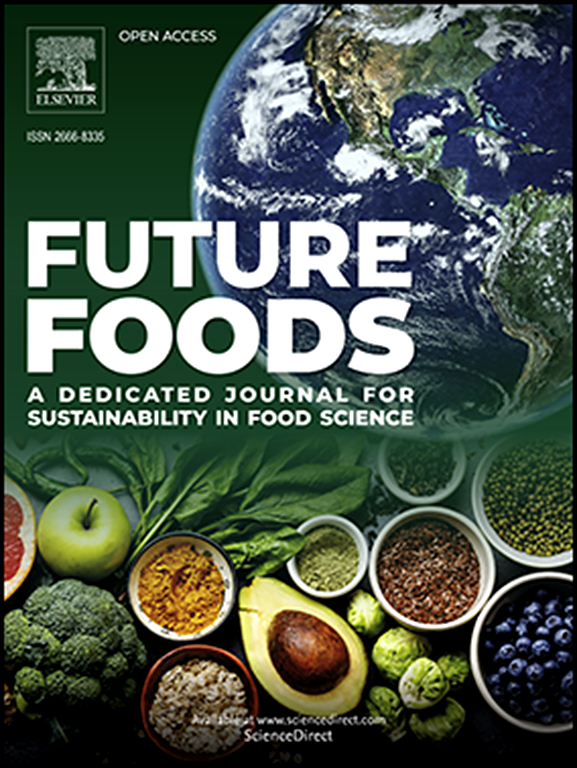Uncovering cocoa shell as a safe bioactive food ingredient: Nutritional and toxicological breakthroughs
IF 7.2
Q1 FOOD SCIENCE & TECHNOLOGY
引用次数: 0
Abstract
This work aimed to analyze the chemical composition of the cocoa shell flour (CSF) and aqueous extract (CSE) and conduct acute and sub-chronic toxicity assays to ensure safety. CSF was composed of 59.1 % dietary fiber, primarily insoluble fiber (48.1 %). CSE consisted entirely of soluble fiber (72.8 %), mainly pectic polysaccharides. The amino acid profile revealed CSF's potential as a high-quality plant protein source, whereas CSE was rich in free amino acids, especially leucine, valine, and alanine (59.6–62.5 mg 100 g−1). Higher levels of macroelements, especially potassium, were found in CSE. Silicon was the most abundant microelement, and heavy metal levels were within acceptable limits for both cocoa shell matrices. This study confirmed the bioactive potential of CSF and CSE, enriched in phenolic compounds and methylxanthines, including theobromine, caffeine, gallic acid, (+)-catechin, as well as N-phenylpropenoyl-l-amino acids. The high theobromine content in both matrices, especially in CSE (2605.3 mg 100 g−1), did not harm the mice's health; acute and sub-chronic toxicity studies demonstrated the safety of oral administration of CSF and CSE in mice, showing no lethality or remarkable histopathological changes. This research supports the safe use of CSF and CSE, establishing these ingredients as suitable for incorporation into food products.

发现可可壳是一种安全的生物活性食品配料:营养学和毒理学方面的突破
这项工作旨在分析可可壳粉(CSF)和水提取物(CSE)的化学成分,并进行急性和亚慢性毒性试验,以确保其安全性。可可壳粉由59.1%的膳食纤维组成,主要是不溶性纤维(48.1%)。CSE 完全由可溶性纤维(72.8%)组成,主要是果胶多糖。氨基酸谱显示 CSF 具有作为优质植物蛋白来源的潜力,而 CSE 则富含游离氨基酸,尤其是亮氨酸、缬氨酸和丙氨酸(59.6-62.5 毫克 100 克-1)。CSE 中含有较多的宏量元素,尤其是钾。硅是含量最高的微量元素,两种可可壳基质的重金属含量都在可接受范围内。这项研究证实了 CSF 和 CSE 的生物活性潜力,它们富含酚类化合物和甲基黄嘌呤,包括可可碱、咖啡因、没食子酸、(+)-儿茶素以及 N-苯基丙烯酰-l-氨基酸。两种基质中的可可碱含量都很高,尤其是 CSE(2605.3 毫克 100 克-1),但这并不会损害小鼠的健康;急性和亚慢性毒性研究表明,小鼠口服 CSF 和 CSE 是安全的,不会致死,也不会出现明显的组织病理学变化。这项研究支持安全使用 CSF 和 CSE,并确定这些成分适合添加到食品中。
本文章由计算机程序翻译,如有差异,请以英文原文为准。
求助全文
约1分钟内获得全文
求助全文
来源期刊

Future Foods
Agricultural and Biological Sciences-Food Science
CiteScore
8.60
自引率
0.00%
发文量
97
审稿时长
15 weeks
期刊介绍:
Future Foods is a specialized journal that is dedicated to tackling the challenges posed by climate change and the need for sustainability in the realm of food production. The journal recognizes the imperative to transform current food manufacturing and consumption practices to meet the dietary needs of a burgeoning global population while simultaneously curbing environmental degradation.
The mission of Future Foods is to disseminate research that aligns with the goal of fostering the development of innovative technologies and alternative food sources to establish more sustainable food systems. The journal is committed to publishing high-quality, peer-reviewed articles that contribute to the advancement of sustainable food practices.
Abstracting and indexing:
Scopus
Directory of Open Access Journals (DOAJ)
Emerging Sources Citation Index (ESCI)
SCImago Journal Rank (SJR)
SNIP
 求助内容:
求助内容: 应助结果提醒方式:
应助结果提醒方式:


